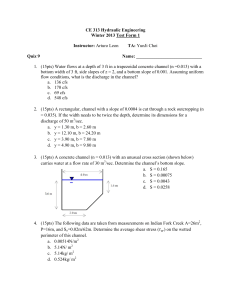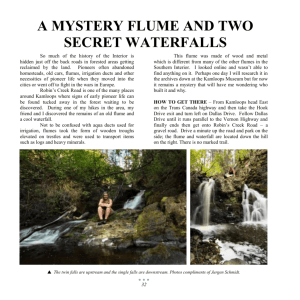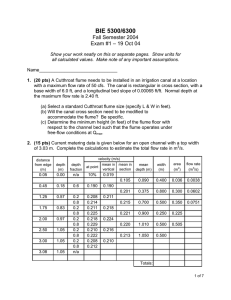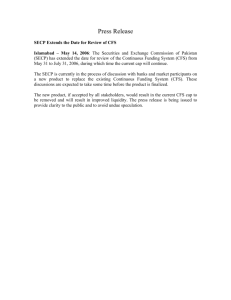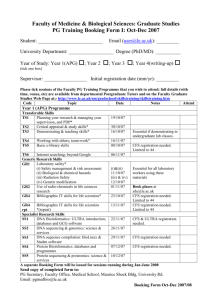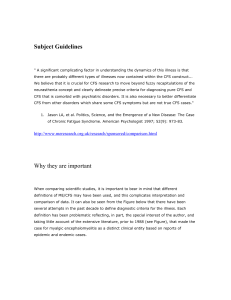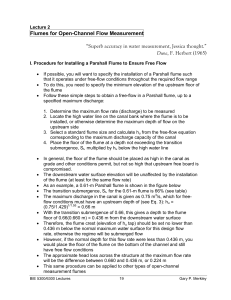BIE 5300/6300 Assignment #1 Simple Flow Measurement and Flumes
advertisement
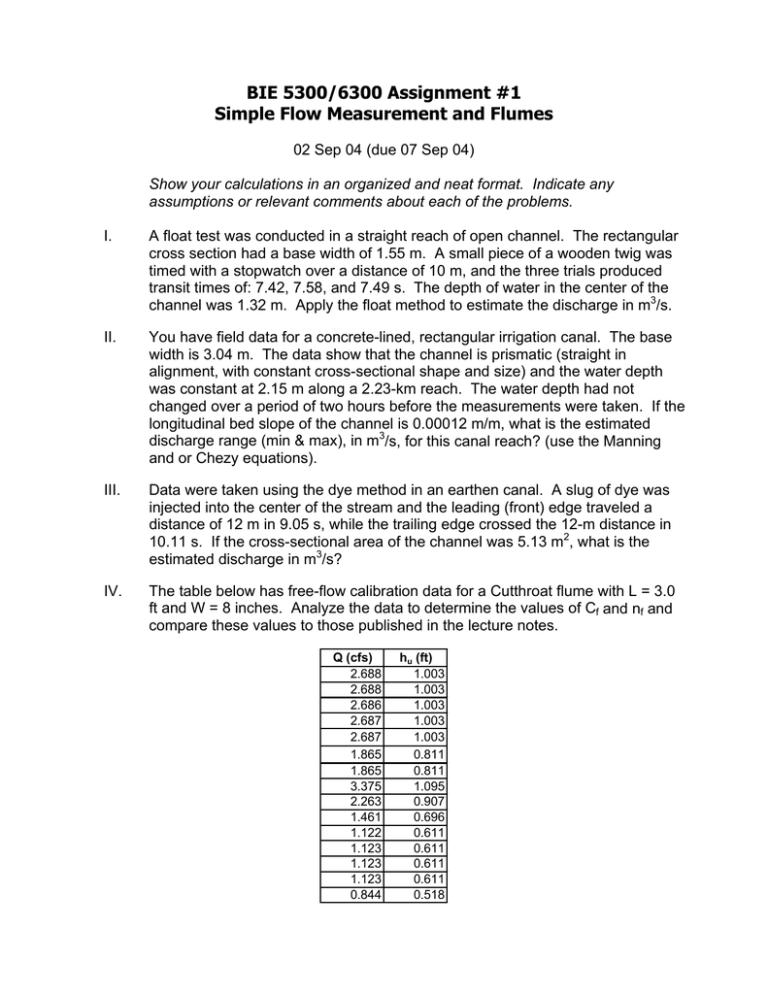
BIE 5300/6300 Assignment #1 Simple Flow Measurement and Flumes 02 Sep 04 (due 07 Sep 04) Show your calculations in an organized and neat format. Indicate any assumptions or relevant comments about each of the problems. I. A float test was conducted in a straight reach of open channel. The rectangular cross section had a base width of 1.55 m. A small piece of a wooden twig was timed with a stopwatch over a distance of 10 m, and the three trials produced transit times of: 7.42, 7.58, and 7.49 s. The depth of water in the center of the channel was 1.32 m. Apply the float method to estimate the discharge in m3/s. II. You have field data for a concrete-lined, rectangular irrigation canal. The base width is 3.04 m. The data show that the channel is prismatic (straight in alignment, with constant cross-sectional shape and size) and the water depth was constant at 2.15 m along a 2.23-km reach. The water depth had not changed over a period of two hours before the measurements were taken. If the longitudinal bed slope of the channel is 0.00012 m/m, what is the estimated discharge range (min & max), in m3/s, for this canal reach? (use the Manning and or Chezy equations). III. Data were taken using the dye method in an earthen canal. A slug of dye was injected into the center of the stream and the leading (front) edge traveled a distance of 12 m in 9.05 s, while the trailing edge crossed the 12-m distance in 10.11 s. If the cross-sectional area of the channel was 5.13 m2, what is the estimated discharge in m3/s? IV. The table below has free-flow calibration data for a Cutthroat flume with L = 3.0 ft and W = 8 inches. Analyze the data to determine the values of Cf and nf and compare these values to those published in the lecture notes. Q (cfs) 2.688 2.688 2.686 2.687 2.687 1.865 1.865 3.375 2.263 1.461 1.122 1.123 1.123 1.123 0.844 hu (ft) 1.003 1.003 1.003 1.003 1.003 0.811 0.811 1.095 0.907 0.696 0.611 0.611 0.611 0.611 0.518 V. The table below has submerged-flow calibration data for a Cutthroat flume with L = 3.0 ft and W = 8 inches. Analyze the data to determine the values of Cs and ns, using the nf value from the previous calibration for the same flume size. Compare these values to those published in the lecture notes. Q (cfs) 2.687 2.687 2.687 2.687 2.687 2.687 2.687 2.685 2.685 2.685 2.683 1.865 1.865 1.865 1.865 1.863 1.863 1.86 1.86 1.86 1.858 1.123 1.123 1.123 1.123 1.123 1.123 1.123 1.12 VI. hu (ft) 1.005 1.008 1.009 1.011 1.013 1.021 1.030 1.055 1.083 1.120 1.183 0.813 0.815 0.820 0.828 0.840 0.905 0.870 0.953 1.077 1.015 0.613 0.617 0.618 0.623 0.638 0.666 0.698 0.828 hd (ft) 0.575 0.602 0.627 0.660 0.689 0.739 0.781 0.863 0.931 0.993 1.093 0.581 0.606 0.639 0.673 0.702 0.826 0.763 0.893 1.025 0.968 0.443 0.468 0.485 0.523 0.560 0.608 0.658 0.805 A Cutthroat flume is to be installed in an existing concrete-lined rectangular canal with a base width of 5.0 ft. The maximum flow rate to be measured at that location is 40 cfs. The longitudinal bed slope of the channel is 0.00045 ft/ft, and the depth of the concrete lining is 3.7 ft. Assume a Manning roughness value of n = 0.015. (a) Select an appropriate Cutthroat flume size, in English units, from the table in the lecture notes. (b) Determine the minimum height of the Cutthroat flume floor, relative to the existing canal bed, such that free-flow conditions prevail up to the maximum discharge of 40 cfs. Do not specify a floor elevation below the existing canal bed. (c) Will the upstream canal banks need to be raised if the Cutthroat flume is installed for free-flow conditions? Solutions: I. The average transit time of the three trials is: (7.42 + 7.58 + 7.49)/3 = 7.50 s. The average estimated surface velocity is: 10 m/7.50 s = 1.33 m/s. Alternatively, the average surface velocity can be taken as (10/7.42 + 10/7.58 + 10/7.49)/3 = 1.33 m/s (same result). The cross-sectional area of the channel is: A = (1.55)(1.32) = 2.05 m2 The average depth in the channel is 1.32 m (because the section is rectangular). Interpolating linearly (which is the simplest option, and probably as valid as anything else in this case) in the table from the lecture notes, the surface velocity coefficient is: 1.32 − 1.22 C − 0.72 = 1.52 − 1.22 0.74 − 0.72 which gives C = 0.73. The average velocity in the cross section is estimated as: (0.73)(1.33 m/s) = 0.97 m/s. Finally, the flow rate is estimated to be: ( ) AV = 2.05 m2 ( 0.97 m/s ) ≈ 2.0 m3 /s II. For this channel cross section size and type of lining, the Manning “n” value might be in the range 0.012 < n < 0.018, depending on the condition of the concrete lining and the presence (or absence) of vegetation and sediment. It probably won’t be less than 0.012, but could be greater than 0.018. The cross-sectional area is: A = (3.04 m)(2.15 m) = 6.54 m2. The wetted perimeter is: Wp = 3.04 + 2(2.15) = 7.34 m. Applying the Manning equation: 1 A5 / 3 1 ( 6.54 ) Q= S = 0.00012 ≈ 5.5 m3 /s o 2/3 2/3 n Wp 0.012 ( 7.34 ) 5/3 at the lower range. Applying the equation again for n = 0.018, we get Q ≈ 3.7 m3/s. Thus, by the Manning equation, you might agree that: 3.7 < Q < 5.5 m3/s. Note that the Manning “n” value has no more than two significant digits in this case, so Q can have no more than that. You could also apply the Chezy equation. These two equations will be discussed further in a future lecture. III. With this method, you don’t apply a coefficient to the measured velocity, which in this case is: V= 12 m = 1.25 m/s 0.5 ( 9.05 + 10.11) Finally, the estimated discharge is: ( ) Q = AV = 5.13 m2 (1.25 m/s) ≈ 6.4 m3 /s IV. The free-flow data were analyzed as shown in the table below, giving Cf = 2.71 and nf = 1.78. Three significant digits are the most that can be justified for this kind of calibration. Note the high coefficient of determination, R2, of 0.998. These results were done in MS Excel®, using the LINEST spreadsheet function. ln(Q) Q (cfs) hu (ft) 2.688 1.003 0.9888 2.688 1.003 0.9888 2.686 1.003 0.9881 2.687 1.003 0.9884 2.687 1.003 0.9884 1.865 0.811 0.6233 1.865 0.811 0.6233 3.375 1.095 1.2164 2.263 0.907 0.8167 1.461 0.696 0.3791 1.122 0.611 0.1151 1.123 0.611 0.1160 1.123 0.611 0.1160 1.123 0.611 0.1160 0.844 0.518 -0.1696 Note: L = 3.0 ft and W = 8 inches ln(hu) 0.0025 0.0025 0.0025 0.0025 0.0025 -0.2097 -0.2097 0.0908 -0.0980 -0.3626 -0.4929 -0.4929 -0.4929 -0.4929 -0.6587 Predicted Percent Q (cfs) Difference 2.7234 -1.31 2.7234 -1.31 2.7234 -1.38 2.7234 -1.35 2.7234 -1.35 1.8665 -0.08 1.8665 -0.08 3.1868 5.74 2.2773 -0.63 1.4215 2.74 1.1272 -0.46 1.1272 -0.37 1.1272 -0.37 1.1272 -0.37 0.8390 0.59 Linear Regression 1.7805 0.9974 0.0212 0.0070 0.9982 0.0198 Cf= nf= 4.07 1.78 Thus, Qf = 4.07 W h1.78 u for W = 8/12 ft; hu in feet; and Qf in cfs. V. The submerged-flow data were analyzed as shown in the table below, also in a spreadsheet application, giving Cs = 1.60 and ns = 1.31. Three significant digits are the most that can be justified for this kind of calibration. The free-flow exponent, nf, was used in this calibration. Note the coefficient of determination, R2, of 0.999. hd (ft) S=hd/hu hu-hd LHS Q (cfs) hu (ft) 2.687 1.005 0.575 0.572 0.430 2.356 2.687 1.008 0.602 0.597 0.406 2.449 2.687 1.009 0.627 0.621 0.383 2.545 2.687 1.011 0.660 0.653 0.351 2.685 2.687 1.013 0.689 0.680 0.324 2.813 2.687 1.021 0.739 0.724 0.282 3.041 2.687 1.030 0.781 0.758 0.249 3.240 2.685 1.055 0.863 0.818 0.192 3.664 2.685 1.083 0.931 0.859 0.153 4.034 2.685 1.120 0.993 0.887 0.127 4.335 2.683 1.183 1.093 0.925 0.089 4.903 1.865 0.813 0.581 0.715 0.232 2.992 1.865 0.815 0.606 0.743 0.209 3.158 1.865 0.820 0.639 0.779 0.181 3.394 1.865 0.828 0.673 0.812 0.156 3.635 1.863 0.840 0.702 0.835 0.138 3.827 1.863 0.905 0.826 0.913 0.079 4.731 1.86 0.870 0.763 0.877 0.107 4.246 1.86 0.953 0.893 0.937 0.060 5.178 1.86 1.077 1.025 0.952 0.052 5.421 1.858 1.015 0.968 0.954 0.047 5.584 1.123 0.613 0.443 0.723 0.170 2.987 1.123 0.617 0.468 0.759 0.148 3.207 1.123 0.618 0.485 0.784 0.133 3.380 1.123 0.623 0.523 0.838 0.101 3.833 1.123 0.638 0.560 0.877 0.078 4.242 1.123 0.666 0.608 0.914 0.058 4.743 1.123 0.698 0.658 0.944 0.039 5.365 1.12 0.828 0.805 0.972 0.023 6.201 Notes: "LHS" is ln(Qs) - nf ln(hu-hd). "RHS" is ln(-log10(S)) Thus, RHS -1.417 -1.497 -1.575 -1.687 -1.787 -1.965 -2.118 -2.441 -2.720 -2.954 -3.380 -1.926 -2.049 -2.224 -2.402 -2.549 -3.225 -2.868 -3.567 -3.846 -3.890 -1.959 -2.124 -2.249 -2.569 -2.867 -3.238 -3.685 -4.389 Predicted Percent Q (cfs) Difference 2.61 2.85 2.64 1.75 2.66 1.01 2.68 0.42 2.69 0.04 2.70 -0.46 2.71 -0.71 2.70 -0.66 2.69 -0.19 2.71 -0.86 2.68 0.09 1.87 -0.22 1.86 0.10 1.85 0.82 1.84 1.51 1.84 1.44 1.80 3.21 1.83 1.55 1.80 3.06 2.04 -9.31 1.83 1.32 1.18 -5.20 1.18 -4.79 1.17 -3.88 1.13 -0.52 1.11 1.24 1.09 2.63 1.05 6.27 1.15 -2.47 Linear Regression -1.311555 0.468977 0.007212 0.019525 0.999184 0.030379 Cs= ns= 2.40 1.31 2.40 W ( hu − hd ) 1.78 Qs = ( − log10 S ) 1.31 for W = 8/12 ft; hu & hd in feet; and Qf in cfs. VI. Referring to the Cutthroat flume table for English units in the lecture notes, and the Cutthroat flume top view figure, it is seen that the width of the flume is B = W + L/4.5. (a) In the table, the smallest Cutthroat flume with a capacity of at least 40 cfs is for W = 3.333 ft and L = 7.50 ft. This gives B = 3.333 + 7.50/4.5 = 5.0 ft, which is the same as the base width of the rectangular canal. This works out just right in this case, so choose the W = 3.333 ft and L = 7.50 ft size. Note that W/L = 4/9. (b) From the calibration table (English units), St = 0.873 for our selected flume size. Free-flow conditions at Qmax give: 1/ nf ⎛Q ⎞ hu = ⎜ max ⎟ ⎝ Cf W ⎠ 1/1.57 ⎛ ⎞ 40 =⎜ ⎟ ⎝ (3.519)(3.333) ⎠ = 2.18 ft Then, Sthu = (0.873)(2.18) = 1.90 ft, which is the maximum downstream depth with respect to the upstream floor elevation. Using the ACA program to determine the normal depth corresponding to the given conditions, at Q = 40 cfs, it is found that the downstream depth would be 3.07 ft. Thus, the floor of the flume must be at least 3.07 – 1.90 = 1.17 ft above the existing canal bed. See the side view figure below. (c) The depth of the concrete lining is given as 3.7 ft. The upstream depth at 40 cfs with the Cutthroat flume in place will be 2.18 + 1.17 = 3.35 ft, which is less than 3.7 ft by a margin of 0.35 ft, which may be enough freeboard in this case. The upstream canal banks do not need to be raised.
